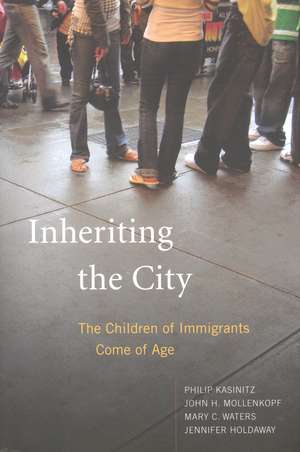Becoming New Yorkers: Ethnographies of the New Second Generation
Editat de Philip Kasinitz, John H. Mollenkopf, Mary C. Watersen Limba Engleză Paperback – 16 aug 2006
More than half of New Yorkers under the age of eighteen are the children of immigrants. This second generation shares with previous waves of immigrant youth the experience of attempting to reconcile their cultural heritage with American society. In Becoming New Yorkers, noted social scientists Philip Kasinitz, John Mollenkopf, and Mary Waters bring together in-depth ethnographies of some of New York's largest immigrant populations to assess the experience of the new second generation and to explore the ways in which they are changing the fabric of American culture. Becoming New Yorkers looks at the experience of specific immigrant groups, with regard to education, jobs, and community life. Exploring immigrant education, Nancy López shows how teachers' low expectations of Dominican males often translate into lower graduation rates for boys than for girls. In the labor market, Dae Young Kim finds that Koreans, young and old alike, believe the second generation should use the opportunities provided by their parents' small business success to pursue less arduous, more rewarding work than their parents. Analyzing civic life, Amy Forester profiles how the high-ranking members of a predominantly black labor union, who came of age fighting for civil rights in the 1960s, adjust to an increasingly large Caribbean membership that sees the leaders not as pioneers but as the old-guard establishment. In a revealing look at how the second-generation views itself, Sherry Ann Butterfield and Aviva Zeltzer-Zubida point out that black West Indian and Russian Jewish immigrants often must choose whether to identify themselves alongside those with similar skin color or to differentiate themselves from both native blacks and whites based on their unique heritage. Like many other groups studied here, these two groups experience race as a fluid, situational category that matters in some contexts but is irrelevant in others. As immigrants move out of gateway cities and into the rest of the country, America will increasingly look like the multicultural society vividly described in Becoming New Yorkers. This insightful work paints a vibrant picture of the experience of second generation Americans as they adjust to American society and help to shape its future.
Preț: 285.99 lei
Nou
Puncte Express: 429
Preț estimativ în valută:
54.72€ • 57.14$ • 45.19£
54.72€ • 57.14$ • 45.19£
Carte indisponibilă temporar
Doresc să fiu notificat când acest titlu va fi disponibil:
Se trimite...
Preluare comenzi: 021 569.72.76
Specificații
ISBN-13: 9780871544377
ISBN-10: 0871544377
Pagini: 431
Dimensiuni: 152 x 229 x 33 mm
Greutate: 0.66 kg
Ediția:Pbk.
Editura: Russell Sage Foundation
Colecția Russell Sage Foundation
ISBN-10: 0871544377
Pagini: 431
Dimensiuni: 152 x 229 x 33 mm
Greutate: 0.66 kg
Ediția:Pbk.
Editura: Russell Sage Foundation
Colecția Russell Sage Foundation
Notă biografică
PHILIP KASINITZ is professor of sociology at the Graduate Center and Hunter College of the City University of New York. JOHN H. MOLLENKOPF is distinguished professor of political science and sociology at the Graduate Center of the City University of New York. MARY C. WATERS is Harvard College Professor and chair of the Department of Sociology at Harvard University. CONTRIBUTORS: Sherri-Ann P. Butterfield, Amy Foerster, Philip Kasinitz, Dae Young Kim, Karen Chai Kim, Sara S. Lee, Nancy Lopez, Vivian Louie, Victoria Malkin, Nicole P. Marwell, John H. Mollenkopf, Alex Trillo, Natasha Warikoo, Mary C. Waters, and Aviva Zeltzer-Zubida
Cuprins
Contributors ix Acknowledgments xi Chapter 1 Worlds of the Second Generation 1 Philip Kasinitz, John H. Mollenkopf, and Mary C. Waters PART I EDUCATION 21 Chapter 2 Unraveling the Race-Gender Gap in Education: Second-Generation Dominican Men's High School Experiences 28 Nancy Ldpez Chapter 3 Somewhere Between Wall Street and El Barrio: Community College as a Second Chance for Second-Generation Latino Students 57 Alex Trillo Chapter 4 "Being Practical" or "Doing What I Want": The Role of Parents in the Academic Choices of Chinese Americans 79 Vivian Louie PART II WORK 111 Chapter 5 Who's Behind the Counter? Retail Workers in New York City 115 Victoria Malkin Chapter 6 Leaving the Ethnic Economy: The Rapid Integration of Second-Generation Korean Americans in New York 154 Dae Young Kim PART III PARTICIPATION 189 Chapter 7 "Isn't Anybody Here from Alabama?": Solidarity and Struggle in a "Mighty, Mighty Union" 197 Amy Foerster Chapter 8 Ethnic and Postethnic Politics in New York City: The Dominican Second Generation 227 Nicole P Marwell Chapter 9 Chinatown or Uptown? Second-Generation Chinese American Protestants in New York City 257 Karen Chai Kim PART IV IDENTITY 281 Chapter 10 "We're Just Black": The Racial and Ethnic Identities of Second-Generation West Indians in New York 288 Sherri-Ann ?P Butterfield Chapter 11 Class Matters: Racial and Ethnic Identities of Working- and Middle-Class Second-Generation Korean Americans in New York City 313 Sara S. Lee Chapter 12 Affinities and Affiliations: The Many Ways of Being a Russian Jewish American 339 Aviva Zeltzer-Zubida Chapter 13 Cosmopolitan Ethnicity: Second-Generation Indo-Caribbean Identities 361 Natasha Warikoo Conclusion Children of Immigrants, Children of America 393 Index 405
